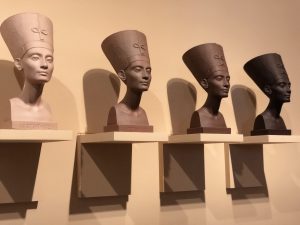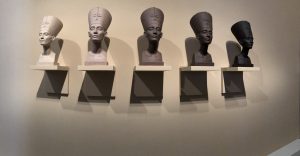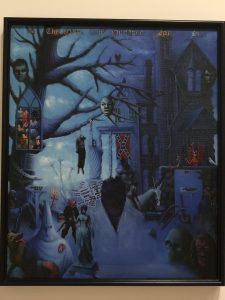The Ancient World exhibit was very eye catching and very interesting. The one piece of artwork that I found so pretty and brilliant was Fred Wilson’s “Grey Area (Brown Version).“This artwork was made of paint, plaster, and wood. It consists of five medium portrait heads of Nerfertiti. All of these heads goes from light to dark shades of brown. Theres not much to say to these portraits but describe how beautiful they are. Nerferitit‘s face is very smooth and all her features are just as smooth and round. The head peace she has on in all five portraits is the only thing that has some sort of grainy texture. The eye immediately goes left to right, and the shades are very admirable. It stands out in the hall that it is in. They’re many elements that add to the artwork. The shadows that that these portraits cast is something that I am not sure was meant to be on purpose but it adds an extra dimension to the already three dimensional artwork. It makes it look more statuesque. The fact that it was put positioned higher than the rest of the artwork also is very admirable.
When I first saw this artwork I already knew what the message it was trying to send. On social media in particular, I remember there was a huge debate of Nerfertiti‘s skin color. People were saying she was of a very dark skin complexion and some were saying she was very light. Wilson deepens that ambiguity of her complexion by creating these portraits.
In making these portraits, Wilson has said “I use beauty as a way of helping people receive difficult or upsetting ideas. The topical issues are merely a vehicle for making one aware of one’s own perceptual shift – which is the real thrill.” What he said captured what this artwork was trying to say. No matterwhat shadeshe was, she was beautiful either way. 








